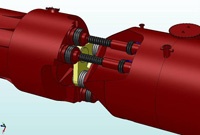Schaeffler’s bearing expertise helps achieve major engineering breakthrough in wave power technology

Working closely with engineers from Pelamis wave power, Schaeffler’s bearing specialists have enabled a major breakthrough in the design of the next generation of renewable wave energy converters. By pushing the boundaries of bearing and seal technology and by thinking ‘outside the box’, a new renewable energy solution has been made possible by the cooperation of two companies both keen to leave a long term legacy of clean energy.
For more than 10 years, engineers at Pelamis Wave Power have been developing a renewable energy solution that offers both commercial viability and low environmental impact. With a company ethos of innovation, constant research and development and a readiness to question and challenge existing technological thinking, Pelamis has succeeded in overcoming the quite incredible engineering challenge of operating continuously in the constantly active and variable marine environment. Building on their experience producing the world’s first offshore wave energy converter, they have developed a ‘P2’ design which is more efficient and cost effective than its predecessors.
Register now to continue reading
Thanks for visiting The Engineer. You’ve now reached your monthly limit of premium content. Register for free to unlock unlimited access to all of our premium content, as well as the latest technology news, industry opinion and special reports.
Benefits of registering
-
In-depth insights and coverage of key emerging trends
-
Unrestricted access to special reports throughout the year
-
Daily technology news delivered straight to your inbox










Water Sector Talent Exodus Could Cripple The Sector
Maybe if things are essential for the running of a country and we want to pay a fair price we should be running these utilities on a not for profit...